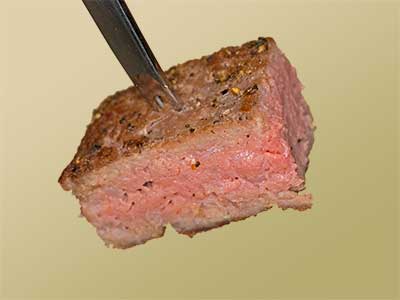June 22, 2015
Amuse-Bouche

le brevet d’invention
(the patent)
Eugene D. Gagliardi, Jr.,is an octogenarian inventor of meat products. His most famous product may be Steak-umms, a method of restructuring thin slices of meat into steak-like planks. I first heard about Gagliardi when a friend emailed me a link to an interview where he was demonstrating a novel, patented method of cutting a chicken breast to make the poultry equivalent of a blooming onion.
I decided to see what else Gagliardi invented. It appears that from 1978 to 2008, Eugene D. Gagliardi, Jr., was issued patents for thirty-eight methods to modify meat. As I glanced through the list, his third patent caught my eye. Issued in 1988, its title is “Restructured meat products and methods of making same.”
The patent’s abstract reads
Restructured meat products are prepared from meat parts which are preferably fresh and without the addition of salt, phosphates and⁄or enzymes before or during the restructuring process. The process comprises slicing the meat parts, preferably across the meat grain, into slices about 1 to 3 mm thick, and preferably about 1.5 to 2 mm thick, said slices having a major surface area about as large as the meat parts will permit, generally averaging greater than about 10 cm2 and preferably greater than about 20 cm2, kneading said slices together in a mass to cause the slices to stick together by means of the natural juices which exude from the meat surface and by entanglement of the slices, and forming the mass of meat slices into a restructured meat product. The restructured meat product may consist of beef, pork, veal, lamb, chicken, turkey or mixtures thereof and may be made in the form of roasts, logs for slicing, cutlets or other convenient meat forms.
To me, the method seems to be just a variation of an earlier patent issued to Dale L. Huffman in 1980. That patent is titled “Process for production of a restructured fresh meat product.” Its abstract reads
A process for restructuring meat wherein chunked and wafer sliced meats are blended to promote release of natural binding proteins. The blended meats are formed into log shapes for freezing and tempering, and then pressed into shape and sliced into steaks or chops. The process produces a roast if the final slicing step is eliminated.
Whether Gagliardi’s patent is novel or not, I decided to give the method a try.
A couple of weeks after that momentous decision, I found a 200-g (7-oz) package of beef outside round in the “Manager’s Special” bin of my local super market. Items become “special” when they are past their sell-by date or look a little oxidized. This piece looked just a tiny bit oxidized when I unwrapped it four days later, by then, well past due. I trimmed and discarded the small amount of fat and gristle from the edge of the slab. The remaining meat was very thinly hand-sliced into wide, flat pieces.
After kneading the meat pieces together for a few minutes, I decided to treat it more aggressively with a mechanical tenderizer. After twenty or so whacks with the tenderizer, the mass of protein still wasn’t very sticky so I repeated the kneading and whacking. After about five minutes, the meat pieces seemed to want to stick together.
I lined both pieces of an 8- x 12-cm (3-3⁄16- by 4-3⁄4-in) cake pan with a separate removable bottom with plastic wrap. The meat was pressed into the pan’s fixed bottom with the pan’s removable bottom. I froze the whole assembly just until the meat was solid. This gave me a solid slab of meat from which I could easily remove the plastic wrap and then vacuum pack without distorting the edges. Once packaged in such a manner, the meat was cooked in a water bath at 54 °C (129 °F) for 3 hours. It was then rapidly chilled in an ice bath.
For service, the meat was removed from the vacuum bag, and its surface dried with absorbent paper. Both sides of the “steak” were given a sprinkling of fine salt and freshly ground black pepper. The meat was very quickly seared in a little neutral oil in a very hot frying pan.
Once seared, the edges were trimmed and the slab of meat cut into 8 pieces. The meat cools quickly so it was served immediately after cutting. A small fork was used for transferring the meat from plate to mouth. Chopsticks or a toothpick also would work.
Was the result worth all the effort? Yes. Definitely yes. Outside round—called bottom round in some regions—is a tough, bland cut of beef. When I trained as a butcher, one of my tasks was to cut the muscle crosswise into very thin slices. The slices would either be sold as is or sold breaded with a mixture of breadcrumbs, parmesan cheese, and dried parsley. The product was very popular because it cooked quickly. I bought some once with my employee discount. I found it still was a bit tough and bland. As a thick slice, outside round is almost impossible to eat. Even slow cooked in a water bath, the meat is still tough and not very flavorful. The pressed meat was tender and flavorful. Yes, it was worth the work.
© 2015 Peter Hertzmann. All rights reserved.
